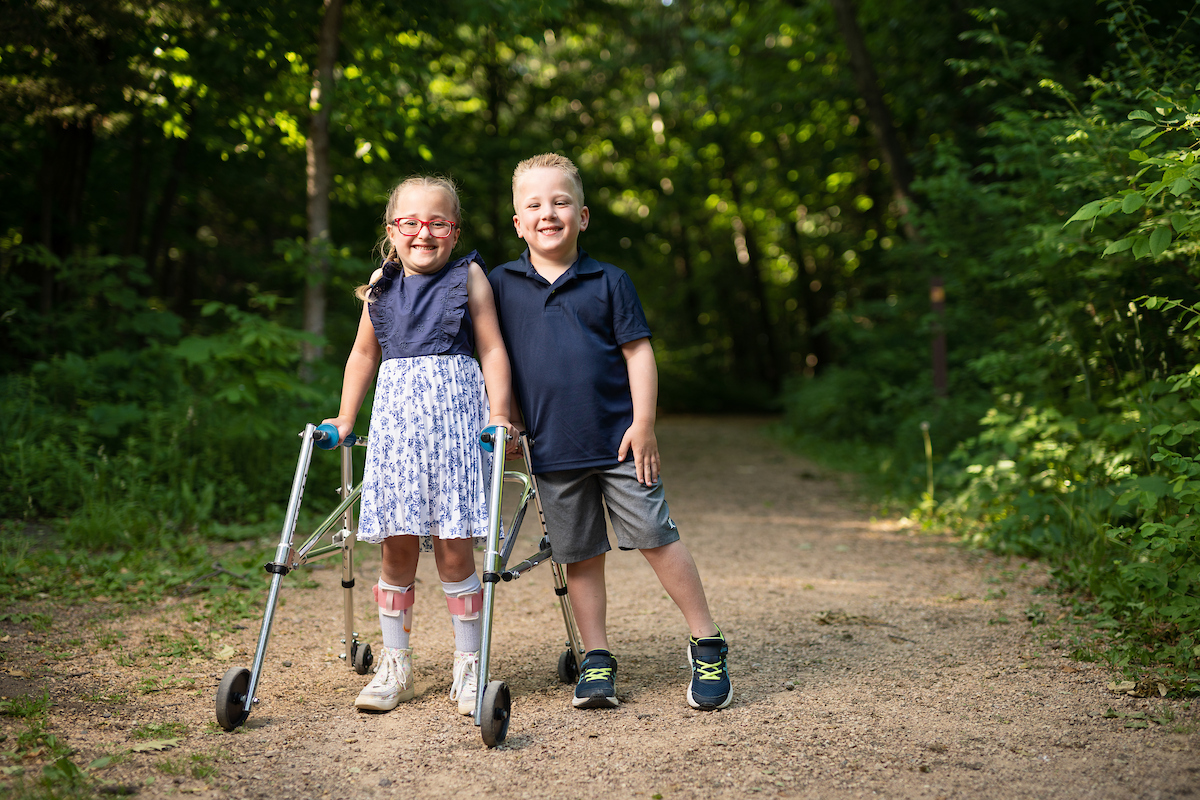What is cerebral palsy?
Cerebral palsy describes a group of disorders that affect a person’s ability to move and maintain balance and posture. It is caused by brain injury or atypical brain development that happens around the time of birth or early in life.
In some infants, symptoms are evident soon after birth. In others, a cerebral palsy diagnosis comes in later infancy or toddlerhood. Cerebral palsy is a permanent condition, but its effects can often progress as people get older.
During your baby’s wellness visits, your healthcare provider will be on the lookout for early signs of cerebral palsy, including:
- Development: Your child is delayed in reaching development milestones like rolling over, sitting, crawling and walking.
- Muscle tone: Your child’s arms and legs are either floppy or too stiff.
- Posture: Your child uses one side of their body more than the other when reaching, crawling, or moving.
- Hearing and vision: Your child seems to have trouble with their vision and hearing.
Children without cerebral palsy may also show some of these signs. But if you notice your child displaying any of the above symptoms, you should talk to your child’s healthcare provider. If your child has cerebral palsy, the sooner they’re diagnosed the more time you have to learn how it will affect them.
Every child who has cerebral palsy has a unique combination of strengths and challenges. No one can predict where your child will fall within this diagnosis. Having cerebral palsy doesn’t mean your child will have cognitive impairment. Only 30 to 50% of children who have cerebral palsy have some level of cognitive impairment, ranging from mild to severe.
The life expectancy for people with cerebral palsy is basically the same as it is for the general population, with most enjoying long, fulfilling and active lives. Early intervention and appropriate treatment of cerebral palsy can help your child improve their abilities and ease their symptoms.
How often does cerebral palsy occur?
The Centers for Disease Control and Prevention report that an average of 1 in 323 children in the US have cerebral palsy, making it the most common of the complex motor disorders in childhood.
What are the types of cerebral palsy?
There are three common types of cerebral palsy with unique symptoms, depending on what part of the brain is affected:
Spastic cerebral palsy is often associated with injury to or developmental differences in the part of the brain called the cerebral cortex. People who have spastic cerebral palsy experience unusually tight and stiff muscles, which can affect movement and growth. Spastic cerebral palsy accounts for about 80% of all cases of cerebral palsy.
Spastic cerebral palsy affects different areas of the body:
- Diplegia affects the legs more than the arms. This type of cerebral palsy is most common in premature babies.
- Hemiplegia affects one side of the body. This type of cerebral palsy is most common in babies who’ve experienced strokes or traumatic brain injuries.
- Quadriplegia affects the entire body — the legs and the arms. This type of cerebral palsy is most common in babies who experience a lack of oxygen.
Dyskinetic cerebral palsy is often associated with damage to the parts of the brain called the basal ganglia and the cerebellum. People who have dyskinetic cerebral palsy experience involuntary movements, such as tremors, or have difficulty balancing and making coordinated movements. They might also experience other types of complex movement disorders.
Mixed cerebral palsy describes people who experience features of spastic and dyskinetic cerebral palsy. This type of cerebral palsy is associated with damage to multiple areas of the brain.
What causes cerebral palsy?
Cerebral palsy occurs in 1.5 to more than 4 of every 1,000 infants born alive. Many factors—such as premature birth and serious illnesses—increase an infant’s risk of having cerebral palsy. In some cases, infants who are born at typical weights and experience no known brain injuries can still have cerebral palsy.
Developing fetuses and infants up to age 1 can develop cerebral palsy if they experience brain injury or disruptions in brain development caused by:
- Bleeding in the brain before, during or after birth.
- Infections of the brain, including meningitis or encephalitis.
- Shock—a state in which organs and tissues don’t receive adequate blood flow
- Traumatic brain injuries.
- Seizures at birth or in the first month following birth.
- Certain genetic conditions.
In some cases, health care providers are unable to determine the precise cause of a child’s pediatric cerebral palsy.
Older children can develop symptoms similar to those of cerebral palsy if they sustain traumatic brain injuries, experience a lack of oxygen, or contract an infection such as meningitis. Children whose injuries occur when they are older receive a diagnosis of brain injury rather than cerebral palsy.
What are the risk factors for cerebral palsy?
A typical pregnancy lasts 40 weeks. Babies born before 37 weeks have a greater risk of having cerebral palsy. The risk increases the earlier a baby is born and the lower the baby’s birth weight. Twins and other multiple-birth siblings are at particular risk because they tend to be born earlier and at lower birth weights.
Infants who experience serious illnesses, strokes, or seizures around the time of birth are at greater risk of also having cerebral palsy. Such illnesses might include:
- Severe jaundice (kernicterus).
- Seizures during the 48 hours after birth.
- Infections of the brain, such as meningitis or encephalitis.
- Strokes caused by broken or clogged blood vessels or abnormal blood cells.
Some cases of cerebral palsy are genetic. Genetic conditions can affect development of the brain or other vital organs, such as the heart. Infants who have genetic and developmental issues are more likely to develop cerebral palsy.
Difficulties during pregnancy and birth—including not enough nutrition through the placenta or a lack of oxygen during labor and birth—can increase the risk of cerebral palsy. Cerebral palsy also is more common when babies and mothers have incompatible blood types (the mother is Rh positive and the baby is Rh negative, or vice versa).
Signs of cerebral palsy in babies often include:
- Show atypical results during a neurological exam in the hours or days after birth.
- Have an Apgar score of less than three (at five minutes after birth).
- Require a mechanical ventilator to breathe.
- Have abnormal MRI scans.
 Home Page
Home Page



